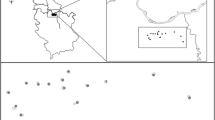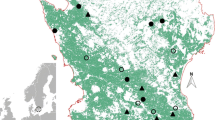Abstract
Context
Manipulating crop diversity in the landscape has been suggested as a promising management option to enhance biocontrol but how crop diversity independently of other important aspects of landscape structure affects predator and pest abundances remain largely unexplored.
Objectives
Our study assessed the relative and interactive effects of crop composition and configuration on aphids and their generalist predators, i.e. ladybirds, spiders and lacewings.
Methods
We sampled arthropods in 47 cotton fields and 21 wheat fields in Hebei, China, located along three landscape gradients: crop diversity (Shannon diversity of crops ranging from 0.27 to 1.32 corresponding to a crop richness varying from 2 to 7 different crops), crop configurational (crop edge density varying from 0.0012 m/ha to 0.066 m/ha) and proportion of semi-natural habitats (varying from 0.5% to 56%).
Results
Crop diversity never had any effect on arthropod communities and we found no effect of the proportion of semi-natural habitats on natural enemies’ abundances. Aphid abundance was positively correlated with the proportion of semi-natural habitats both in cotton and wheat fields. Lacewing abundance benefited from configurational heterogeneity as abundances increased with crop edge density.
Conclusions
Our result provide evidence that crop diversity is probably not the best management option to enhance biocontrol of aphids in Chinese landscapes and confirms that the amount of semi-natural habitats in the landscape is a critical aspect shaping arthropod communities. It also indicates that manipulating crop edge density by promoting agricultural landscapes with small field size for instance can benefit natural enemies of crop pests.




Similar content being viewed by others
Data availability
The datasets generated during and/or analysed during the current study are available from the corresponding author on reasonable request.
References
Aguilera G, Roslin T, Miller K, Tamburini G, Birkhofer K, Caballero-Lopez B, Lindström SAM, Öckinger E, Rundlöf M, Rusch A, Smith HG, Bommarco R (2020) Crop diversity benefits carabid and pollinator communities in landscapes with semi-natural habitats. J Appl Ecol 57(11):2170–2179
Ali A, Desneux N, Lu YH, Wu KM (2018) Key aphid natural enemies showing positive effects on wheat yield through biocontrol services in northern China. Agr Ecosyst Environ 266:1–9
Badenhausser I, Gross N, Mornet V, Roncoroni M, Saintilan A, Rusch A (2020) Increasing amount and quality of green infrastructures at different scales promotes biological control in agricultural landscapes. Agric Ecosyst Environ 290:106735
Barton K (2018) MuMIn: multi-model inference. R Package Version 1(42):1
Bates D, Maechler M, Bolker B, Walker S (2015) Fitting linear mixed-effects models using lme4. J Stat Softw 67(1):1–48
Bianchi F, Booij C, Tscharntke T (2006) Sustainable pest regulation in agricultural landscapes: a review on landscapes composition, biodiversity and natural pest control. Proc Biol Sci 273:1715–1727
Blitzer EJ, Dormann CF, Holzschuh A, Klein AM, Rand TA, Tscharntke T (2012) Spillover of functionally important organisms between managed and natural habitats. Agr Ecosyst Environ 146(1):34–43
Bommarco R, Kleijn D, Potts SG (2013) Ecological intensification: harnessing ecosystem services for food security. Trends Ecol Evol 28(4):230–238
Cornara D, Panzarino O, Santoiemma G, Bodino N, Loverre P, Mastronardi MG et al (2021) Natural areas as reservoir of candidate vectors of Xylella fastidiosa. Bull Insectology 74:173–180
Delbac L, Rusch A, Thiéry D (2020) Temporal dynamics of Drosophila suzukii in vineyard landscapes. Entomol Gen 40:285–295
Desneux N, Decourtye A, Delpuech JM (2007) The sublethal effects of pesticides on beneficial arthropods. Ann Rev Entomol 52:81–106
Dudley N, Alexander S (2017) Agriculture and biodiversity: a review. Biodiversity 18(2–3):45–49
Etienne L, Franck P, Lavigne C, Papaïx J, Tolle P, Ostandie N, Rusch A (2022) Pesticide use in vineyards is affected by semi-natural habitats and organic farming share in the landscape. Agric Ecosyst Environ 333:107967
Fahrig L, Baudry J, Brotons L, Burel FG, Crist TO, Fuller RJ et al (2011) Functional landscape heterogeneity and animal biodiversity in agricultural landscapes. Ecol Lett 14(2):101–112
Gagic V, Holding M, Venables WN, Hulthen AD, Schellhorn NA (2021) Better outcomes for pest pressure, insecticide use, and yield in less intensive agricultural landscapes. Proc Natl Acad Sci USA 118(12):e2018100118
Han P, Lavoir AV, Rodriguez-Saona C, Desneux N (2022) Bottom-up forces in agroecosystems and their potential impact on arthropod pest management. Ann Rev Entomol 67:239–259
Hartig F (2018) DHARMa: Residual Diagnostics for Hierarchical (Multi-Level/Mixed) Regression Models. R package version 0.2.0. Accessed 2019
Hass AL, Kormann UG, Tscharntke T, Clough Y, Baillod AB, Sirami C et al (2018) Landscape configurational heterogeneity by small-scale agriculture, not crop diversity, maintains pollinators and plant reproduction in western Europe. Proc Royal Soc B 285(1872):20172242
Holland JM, Bianchi FJ, Entling MH, Moonen AC, Smith BM, Jeanneret P (2016) Structure, function and management of semi-natural habitats for conservation biological control: a review of European studies. Pest Manag Sci 72(9):1638–1651
Hulle M, Chaubet B, Turpeau E, Simon JC (2020) Encyclop’Aphid: A website on aphids and their natural enemies. Entomol Generalis 40:97–101
Jung M (2016) LecoS—A python plugin for automated landscape ecology analysis. Ecol inform 31:18–21
Karp DS, Chaplin-Kramer R, Meehan TD, Martin EA, DeClerck F, Grab H, Gratton C, Hunt L, Larsen AE, Martínez-Salinas A, O’Rourke ME (2018) Crop pests and predators exhibit inconsistent responses to surrounding landscape composition. Proc Natl Acad Sci USA 115(33):E7863–E7870
Kheirodin A, Cárcamo HA, Costamagna AC (2020) Contrasting effects of host crops and crop diversity on the abundance and parasitism of a specialist herbivore in agricultural landscapes. Landscape Ecol 35(5):1073–1087
Li Y, Zhang C, Yin Y, Cui F, Cai J, Chen Z et al (2014) Neurological effects of pesticide use among farmers in China. Int J Environ Res Public Health 11(4):3995–4006
Liu B, Yang L, Yang Y, Lu Y (2016) Influence of landscape diversity and composition on the parasitism of cotton bollworm eggs in maize. PLoS ONE 11(2):e0149476
Liu B, Yang L, Zeng Y, Yang F, Yang Y, Lu Y (2018) Secondary crops and non-crop habitats within landscapes enhance the abundance and diversity of generalist predators. Agric Ecos and Env 258:30–39
Lüdecke D (2018). sjPlot: Data Visualization for Statistics in Social Science. https://doi.org/10.5281/zenodo.1308157
Martin EA, Seo B, Park CR, Reineking B, Steffan-Dewenter I (2016) Scale-dependent effects of landscape composition and configuration on natural enemy diversity, crop herbivory, and yields. Ecol Appl 26(2):448–462
Martin EA, Dainese M, Clough Y, Báldi A, Bommarco R, Gagic V, Garratt MP, Holzschuh A, Kleijn D, Kovács-Hostyánszki A, Marini L (2019) The interplay of landscape composition and configuration: new pathways to manage functional biodiversity and agroecosystem services across Europe. Ecol Lett. https://doi.org/10.1111/ele.13265
Pan HS, Liu B, Lu YH (2019) Host-plant switching promotes the population growth of Apolygus lucorum: implications for laboratory rearing. Bull Entomol Res 109(3):309–315
Perović DJ, Gámez-Virués S, Landis DA, Wäckers F, Gurr GM, Wratten SD, You MS, Desneux N (2018) Managing biological control services through multi-trophic trait interactions: review and guidelines for implementation at local and landscape scales. Biol Rev 93:306–321
Rand TA, Tylianakis JM, Tscharntke T (2006) Spill-over edge effects: the dispersal of agriculturally subsidized insect natural enemies into adjacent natural habitats. Ecol Lett 9:603–614
Rand TA, Waters DK, Blodgett SL, Knodel JJ, Harris MO (2014) Increased area of a highly suitable host crop increases herbivore pressure in intensified agricultural landscapes. Agr Ecosyst Environ 186:135–143
Raven PH, Wagner DL (2021) Agricultural intensification and climate change are rapidly decreasing insect biodiversity. Proc Natl Acad Sci USA. https://doi.org/10.1073/pnas.2002548117
R Core Team (2018) R: a language and environment for statistical computing
Redlich S, Martin EA, Steffan-Dewenter I (2018) Landscape-level crop diversity benefits biological pest control. J Appl Ecol. https://doi.org/10.1111/1365-2664.13126
Rusch A, Valantin-Morison M, Sarthou JP, Roger-Estrade J (2010) Biological control of insect pests in agroecosystems: effects of crop management, farming systems, and semi-natural habitats at the landscape scale: a review. Adv Agron 109:219–259
Rusch A, Chapelin-Kramer R, Gardiner MM, Hawro V, Holland J, Landis D, Thies C, Tscharntke T, Weisser WW, Winqvist C, Woltz M, Bommarco R (2016) Agricultural landscape simplification reduces natural pest control: a quantitative synthesis. Agr Ecosyst Environ 221:198–204
Schellhorn NA, Gagic V, Bommarco R (2015) Time will tell: resource continuity bolsters ecosystem services. Trends Ecol Evol 30:524–530
Thomine E, Rusch A, Supplisson C, Monticelli LS, Amiens-Desneux E, Lavoir AV, Desneux N (2020a) Highly diversified crop systems can promote the dispersal and foraging activity of the generalist predator Harmonia axyridis. Entomol Gen 40:133–145
Thomine E, Jeavons E, Rusch A, Bearez P, Desneux N (2020b) Effect of crop diversity on predation activity and population dynamics of the mirid predator Nesidiocoris tenuis. J Pest Sci 93:1255–1265
Thomine E, Mumford J, Rusch A, Desneux N (2021) Using crop diversity to lower pesticide use: Socio-ecological approaches. Sci Total Environ 804:150156
Tscharntke T, Karp DS, Chaplin-Kramer R, Batáry P, DeClerck F, Gratton C et al (2016) When natural habitat fails to enhance biological pest control—Five hypotheses. Biol Conserv 204:449–458
Veres A, Petit S, Conord C, Lavigne C (2013) Does landscape composition affect pest abundance and their control by natural enemies? A review. Agr Ecosyst Environ 166:110–117
Wickham H (2016) ggplot2: Elegant graphics for data analysis. Springer-Verlag, New York
Wratten SD, Gillespie M, Decourtye A, Mader E, Desneux N (2012) Pollinator habitat enhancement: benefits to other ecosystem services. Agric Ecosyst Environ 159:112–122
Yang F, Yao ZW, Zhu YL, Wu YK, Liu LT et al (2020) A molecular detection approach for assessing wheat aphid-parasitoid food webs in northern China. Entomol Generalis 40:273–284
Zhao H, Li J, Guo L, Wang K (2021) Crop diversity at the landscape level affects the composition and structure of the vegetation-dwelling arthropod communities in naked oat (Avena chinensis) fields. Int J Environ Res Public Health 18(1):30
Acknowledgements
The authors are grateful for professors Bing Lui and Lu Yan Hui and for the students of the IPP CAAS for providing the data.
Funding
This work was supported by EUCLID project financed by H2020 program (Grant Number 633999).
Author information
Authors and Affiliations
Contributions
All authors contributed to the study conception and design. Data collection and analysis were performed by ET and AR. The first draft of the manuscript was written by ET and all authors contributed to the manuscript. All authors read and approved the final manuscript.
Corresponding authors
Ethics declarations
Conflict of interest
The authors have no relevant financial or non-financial interests to disclose.
Additional information
Publisher's Note
Springer Nature remains neutral with regard to jurisdictional claims in published maps and institutional affiliations.
Supplementary Information
Below is the link to the electronic supplementary material.
Rights and permissions
Springer Nature or its licensor (e.g. a society or other partner) holds exclusive rights to this article under a publishing agreement with the author(s) or other rightsholder(s); author self-archiving of the accepted manuscript version of this article is solely governed by the terms of such publishing agreement and applicable law.
About this article
Cite this article
Thomine, E., Rusch, A. & Desneux, N. Predators do not benefit from crop diversity but respond to configurational heterogeneity in wheat and cotton fields. Landsc Ecol 38, 439–447 (2023). https://doi.org/10.1007/s10980-022-01574-x
Received:
Accepted:
Published:
Issue Date:
DOI: https://doi.org/10.1007/s10980-022-01574-x




